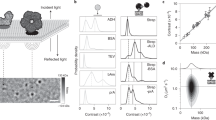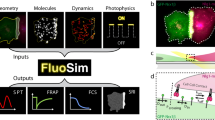Abstract
Although the highly dynamic and mosaic organization of the plasma membrane is well-recognized, depicting a resolved, global view of this organization remains challenging. We present an analytical single-particle tracking (SPT) method and tool, multiple-target tracing (MTT), that takes advantage of the high spatial resolution provided by single-fluorophore sensitivity. MTT can be used to generate dynamic maps at high densities of tracked particles, thereby providing global representation of molecular dynamics in cell membranes. Deflation by subtracting detected peaks allows detection of lower-intensity peaks. We exhaustively detected particles using MTT, with performance reaching theoretical limits, and then reconnected trajectories integrating the statistical information from past trajectories. We demonstrate the potential of this method by applying it to the epidermal growth factor receptor (EGFR) labeled with quantum dots (Qdots), in the plasma membrane of live cells. We anticipate the use of MTT to explore molecular dynamics and interactions at the cell membrane.
This is a preview of subscription content, access via your institution
Access options
Subscribe to this journal
Receive 12 print issues and online access
$259.00 per year
only $21.58 per issue
Buy this article
- Purchase on Springer Link
- Instant access to full article PDF
Prices may be subject to local taxes which are calculated during checkout






Similar content being viewed by others
References
Saxton, M.J. & Jacobson, K. Single-particle tracking: applications to membrane dynamics. Annu. Rev. Biophys. Biomol. Struct. 26, 373–399 (1997).
Lippincott-Schwartz, J., Altan-Bonnet, N. & Patterson, G.H. Photobleaching and photoactivation: following protein dynamics in living cells. Nat. Cell Biol. 5 (Suppl.), S7–S14 (2003).
Lommerse, P.H., Spaink, H.P. & Schmidt, T. In vivo plasma membrane organization: results of biophysical approaches. Biochim. Biophys. Acta 1664, 119–131 (2004).
Marguet, D., Lenne, P.F., Rigneault, H. & He, H.T. Dynamics in the plasma membrane: how to combine fluidity and order. EMBO J. 25, 3446–3457 (2006).
Wawrezinieck, L., Rigneault, H., Marguet, D. & Lenne, P.F. Fluorescence correlation spectroscopy diffusion laws to probe the submicron cell membrane organization. Biophys. J. 89, 4029–4042 (2005).
Lenne, P.F. et al. Dynamic molecular confinement in the plasma membrane by microdomains and the cytoskeleton meshwork. EMBO J. 25, 3245–3256 (2006).
Meijering, E., Smal, I. & Danuser, G. Tracking in molecular bioimaging. IEEE Signal Process. Mag. 23, 46–53 (2006).
Michalet, X. et al. Quantum dots for live cells, in vivo imaging, and diagnostics. Science 307, 538–544 (2005).
Dahan, M. et al. Diffusion dynamics of glycine receptors revealed by single-quantum dot tracking. Science 302, 442–445 (2003).
Lidke, D.S. et al. Quantum dot ligands provide new insights into erbB/HER receptor-mediated signal transduction. Nat. Biotechnol. 22, 198–203 (2004).
Schmidt, T., Schutz, G.J., Baumgartner, W., Gruber, H.J. & Schindler, H. Imaging of single molecule diffusion. Proc. Natl. Acad. Sci. USA 93, 2926–2929 (1996).
Kalaidzidis, Y. Intracellular objects tracking. Eur. J. Cell Biol. 86, 569–578 (2007).
Schlessinger, J. Ligand-induced, receptor-mediated dimerization and activation of EGF receptor. Cell 110, 669–672 (2002).
Tang, J. & Marcus, R.A. Mechanisms of fluorescence blinking in semiconductor nanocrystal quantum dots. J. Chem. Phys. 123, 054704 (2005).
Cheezum, M.K., Walker, W.F. & Guilford, W.H. Quantitative comparison of algorithms for tracking single fluorescent particles. Biophys. J. 81, 2378–2388 (2001).
Bonneau, S., Dahan, M. & Cohen, L.D. Single quantum dot tracking based on perceptual grouping using minimal paths in a spatiotemporal volume. IEEE Trans. Image Process. 14, 1384–1395 (2005).
Ober, R.J., Ram, S. & Ward, E.S. Localization accuracy in single-molecule microscopy. Biophys. J. 86, 1185–1200 (2004).
Dietrich, C., Yang, B., Fujiwara, T., Kusumi, A. & Jacobson, K. Relationship of lipid rafts to transient confinement zones detected by single particle tracking. Biophys. J. 82, 274–284 (2002).
Meier, J., Vannier, C., Serge, A., Triller, A. & Choquet, D. Fast and reversible trapping of surface glycine receptors by gephyrin. Nat. Neurosci. 4, 253–260 (2001).
Meilhac, N., Le Guyader, L., Salome, L. & Destainville, N. Detection of confinement and jumps in single-molecule membrane trajectories. Phys. Rev. E 73, 011915 (2006).
Saxton, M.J. Single-particle tracking: effects of corrals. Biophys. J. 69, 389–398 (1995).
Simson, R., Sheets, E.D. & Jacobson, K. Detection of temporary lateral confinement of membrane proteins using single-particle tracking analysis. Biophys. J. 69, 989–993 (1995).
Wiley, H.S. Trafficking of the ErbB receptors and its influence on signaling. Exp. Cell Res. 284, 78–88 (2003).
Teramura, Y. et al. Single-molecule analysis of epidermal growth factor binding on the surface of living cells. EMBO J. 25, 4215–4222 (2006).
Orr, G. et al. Cholesterol dictates the freedom of EGF receptors and HER2 in the plane of the membrane. Biophys. J. 89, 1362–1373 (2005).
Kusumi, A. et al. Paradigm shift of the plasma membrane concept from the two-dimensional continuum fluid to the partitioned fluid: high-speed single-molecule tracking of membrane molecules. Annu. Rev. Biophys. Biomol. Struct. 34, 351–378 (2005).
Schutz, G.J., Kada, G., Pastushenko, V.P. & Schindler, H. Properties of lipid microdomains in a muscle cell membrane visualized by single molecule microscopy. EMBO J. 19, 892–901 (2000).
Daumas, F. et al. Confined diffusion without fences of a g-protein-coupled receptor as revealed by single particle tracking. Biophys. J. 84, 356–366 (2003).
Puri, C. et al. Relationships between EGFR signaling-competent and endocytosis-competent membrane microdomains. Mol. Biol. Cell 16, 2704–2718 (2005).
Yamabhai, M. & Anderson, R.G. Second cysteine-rich region of epidermal growth factor receptor contains targeting information for caveolae/rafts. J. Biol. Chem. 277, 24843–24846 (2002).
Seisenberger, G. et al. Real-time single-molecule imaging of the infection pathway of an adeno-associated virus. Science 294, 1929–1932 (2001).
Moerner, W.E. Single-molecule mountains yield nanoscale cell images. Nat. Methods 3, 781–782 (2006).
Manley, S. et al. High-density mapping of single-molecule trajectories with photoactivated localization microscopy. Nat. Methods 5, 155–157 (2008).
Acknowledgements
We thank H.T. He, L. Leserman, P. Réfrégier, F. Conchonaud, S. Mailfert and M. Fallet for helpful discussions and suggestions, and E. Witty (AngloScribe) for language editing. This project was supported by grants from Institut National de la Santé et de la Recherche Médicale, Centre National de la Recherche Scientifique, Agence Nationale de la Recherche and European regional development fund.
Author information
Authors and Affiliations
Contributions
H.R. and D.M. designed the research; A.S. and N.B. performed the research, developed new analytical tools and analyzed data; A.S. and D.M. wrote the paper.
Corresponding author
Supplementary information
Supplementary Text and Figures
Supplementary Figures 1–5, Supplementary Methods, Supplementary Table 1 and Supplementary Note (PDF 4011 kb)
Supplementary Video 1
MTT computation on experimental data. The left part is the raw image corresponding to the cell depicted in Fig. 5b and the right part illustrates the MTT process, corresponding to the 120 × 80 pixels area zoomed in on in Supplementary Fig. 2. Two circles (with pseudo-colors for clarity purpose) delimit the concentric reconnection domains associated to local and maximal diffusion of each particle, eventually increasing after blink (Fig. 3). Images were acquired as described, at 36 ms acquisition time (28 fps). (MOV 1242 kb)
Supplementary Video 2
Spatial variations of EGFR confinement. Each frame of the video was independently computed as in Fig. 5c, from an acquisition stack of 1,000 frames (corresponding to 36 s) as a contour plot of the local confinement level. Contours were calculated by cubic interpolation through (x, y, Log(Lconf)) points using Matlab. Each pixel can account for up to tens of trajectories (Fig. 6c). In these cases, the mean value of Lconf was used. To generate a movie instead of a map, contours were generated frame by frame and recorded at 2× reduced speed (14 fps). Using high-density labeling, non-labeled regions corresponded to a reasonably low fraction of the membrane. They were either interpolated or left as gaps in the surface, according to their surrounding values. Temporal smoothing over 3 frames was performed to improve visual quality. Non-specific binding to the coverslip around the cell was discarded by computing the cell contour using the DIC image. Image size is 61.5 × 51.25 μm, at 100× magnification, using the same color-scale as in Fig. 5c. (MOV 2822 kb)
Supplementary Video 3
3× zoom of Supplementary Video 2. This video was recorded at 2× reduced speed (14 fps). Image width is 20.5 μm. (MOV 3239 kb)
Rights and permissions
About this article
Cite this article
Sergé, A., Bertaux, N., Rigneault, H. et al. Dynamic multiple-target tracing to probe spatiotemporal cartography of cell membranes. Nat Methods 5, 687–694 (2008). https://doi.org/10.1038/nmeth.1233
Received:
Accepted:
Published:
Issue Date:
DOI: https://doi.org/10.1038/nmeth.1233
This article is cited by
-
Confinement of unliganded EGFR by tetraspanin nanodomains gates EGFR ligand binding and signaling
Nature Communications (2023)
-
YTHDF2 facilitates aggresome formation via UPF1 in an m6A-independent manner
Nature Communications (2023)
-
Combined SPT and FCS methods reveal a mechanism of RNAP II oversampling in cell nuclei
Scientific Reports (2023)
-
Quantifying postsynaptic receptor dynamics: insights into synaptic function
Nature Reviews Neuroscience (2023)
-
Single molecule analyses reveal dynamics of Salmonella translocated effector proteins in host cell endomembranes
Nature Communications (2023)



